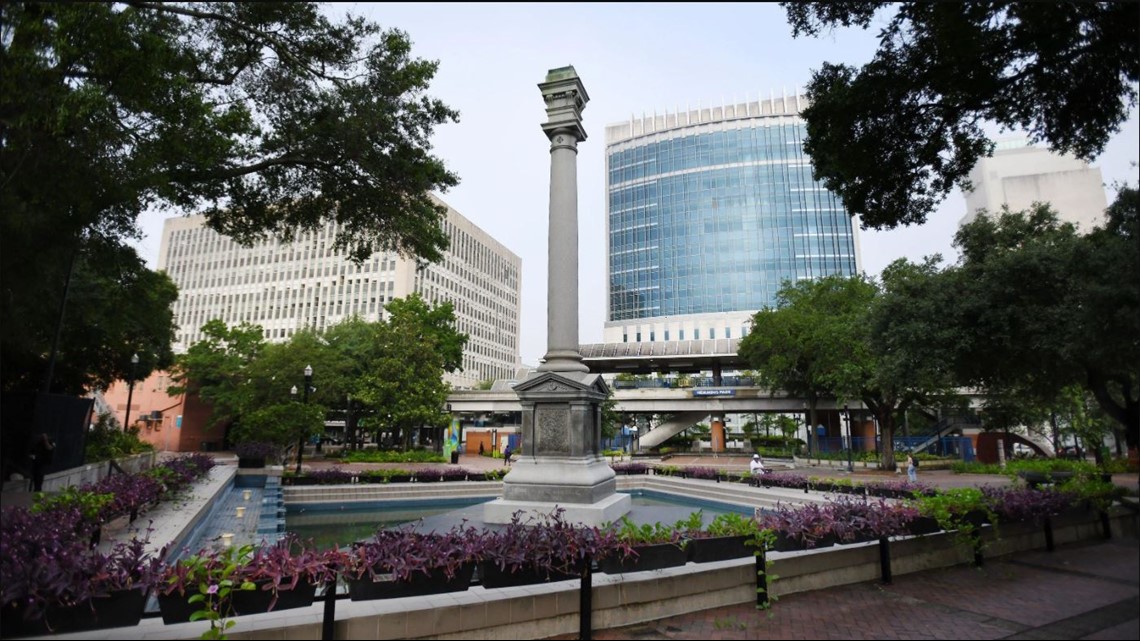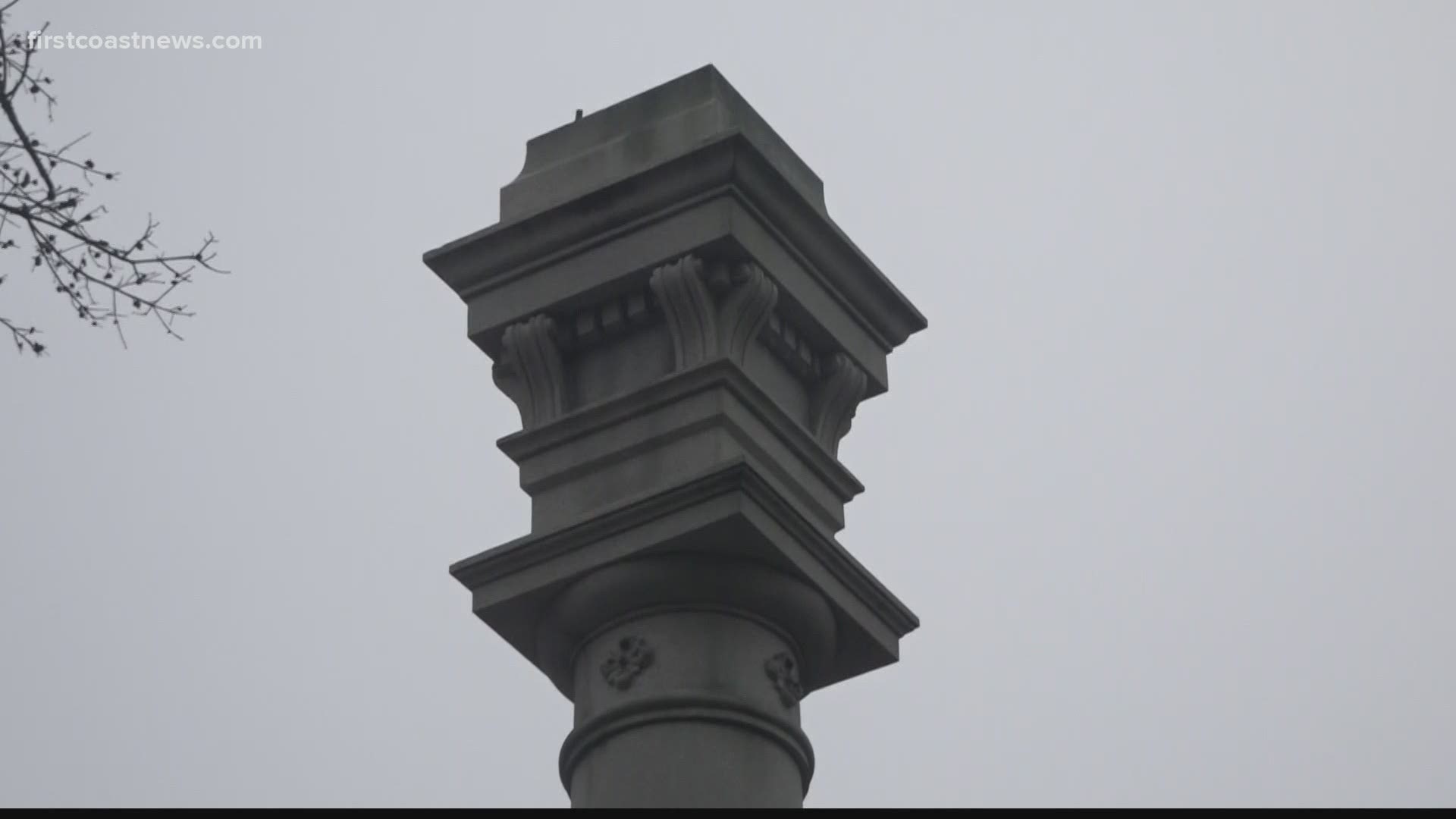JACKSONVILLE, Fla — After 122 years, it was gone in minutes — the nameless Confederate soldier plucked from its pillar and hauled away in the early morning dark of June 9.
The urgency was understandable. All across the country, Confederate statues were being removed, whether by force or fiat. The Civil War marker in Jacksonville's center square had been a source of controversy for years. And for a mayor who would announce just two days later that the RNC was coming to Jacksonville, getting rid of it quickly and without drama made political sense.
What makes less sense is some of the 10 other Confederate monuments and markers slated for removal. A day after the statue was dismantled, Mayor Lenny Curry released a list of 11 items that included three monuments celebrating the Confederacy (including the already-removed soldier), and eight historical markers. Some of the markers clearly celebrate the Civil War – like the “In Memory of our Beloved Ancestors” plaque in the Old City Cemetery.
But others are garden variety historical markers, describing actual events in the uninflected cadence so familiar to middle school history students. The text from one of the markers can be read at the bottom of this story. Several were placed in the past 10 years.
“Definitely a lot of the historic markers are important, and they’re correct they should be retained as part of the city’s recollection of events that happened in our town,” says author and historian Dr. Wayne Wood.
Wood notes that the historic, artistic and civic community was not part of creating the list. The historic markers aren’t even on the list created by Take ‘Em Down Jax, the primary activist group calling for the removal of racist iconography.
Discovering just where the list came from is a bit of a mystery.
The day after it was released, First Coast News asked the city for any “emails, texts, draft documents, invoices, memos and any other communications related to the city’s removal of Confederate monuments from May 25 forward.”
The city’s response: There is nothing responsive to this request.
Nothing?
We emailed back, “Guessing there must be some work product that went into creating that list? Right?”
Evidently not, so First Coast News sent in seven questions, as shown below, to learn more about how the list was created. The response took another 10 days. Their answers appear in bold:
1. What are the names of the people and/or agencies who helped come up with the list of 11 monuments/markers for removal? The Planning Department developed the list.
2. What sourced information did they employ in creating the list? Historical files
3. Where and via what mode of communication did those discussions take place? NA (Not available)
4. When did discussions begin and when did they wrap up (i.e. when was the list finalized) The Planning Department created the list under the direction of Anna Brosche during her time as Council president; the information shared during that time (approx. two years ago) is the same being used now.
5. Were there some monuments/markers discussed that did not make the final cut. If so, which? See answer to Q4
6. Who created the document “civil war related monuments” that was emailed to media Tuesday, June 9, 2020 1:00 PM. May I please request a version of that document that includes all metadata and editing history? The Planning Department created the document; there is no version with metadata and editing history.
7. Where or who did the information included in that document come from? NA


The list that the Planning Department produced is actually an inventory created at the direction of former City Council President Anna Brosche in 2017, intended as a starting point for community dialogue. However, the discussion was cut short. Following intense backlash by the community and some colleagues, she abandoned the effort.
At an Aug. 12 press conference, First Coast News asked Mayor Curry how such a consequential and costly list came into being without generating a paper trail. He didn’t directly address the question, saying, “Look if there’s a paper trail and a public record and you’ve requested it, you should have it or you should get it.”
He promised to follow up on the matter. The next day, the city located two emails – one sent June 10 to the Chief of Procurement with a receipt for the Confederate statue removal, and the chief’s reply back, retroactively approving the expenditure. (It cost $7,302.)
Curry promised to involve the community in discussions about where the markers will be re-located but was adamant that the list is final. “When they’re moved – and they will be moved – where they will be removed and contextualized based on history,” he said.
Below is the text of the historic plaque titled, “The Sinking of Maple Leaf.” It was placed on the Northbank Riverwalk in 2010.
"Approximately 15 miles up river from this point, the Union transport Maple Leaf was destroyed by a Confederate mine during the early morning hours of April 1, 1864. The Maple Leaf sank to the bottom of the St. Johns River after hitting one of twelve Confederate mines along Mandarin Point. At the time of the explosion, the steamboat was transporting 68 passengers and crewmembers from Palatka to Jacksonville.
Passengers included 42 Union sympathizers seeking protection of federal troops in Jacksonville. Four crew members died in the explosion. After sinking, only the top of the wheelhouse and smokestack were visible. These parts were later removed to keep the channel clear for navigation. The hull with its valuable cargo had settled deep within the muddy river bottom. On the Maple Leaf were 400 pounds of cargo, primarily the equipment of three Union regiments and two brigade headquarters.
In 1981the Maple Leaf was located by St. Johns Archaeological Expeditions, Inc. Hundreds of artifacts have been recovered from the site, which is now a National Landmark."

